People eating with chopsticks© Edwin Tan/Getty Images
By Jenny Latreille
Editor’s Note: This is the second installment of the article originally appeared as a single article
Misusing Chopsticks
Speaking of flipping those chopsticks around, let us give you a head’s up about proper etiquette for this utensil. First, if anything you’re planning on doing with them involves only half a set — just stop. Chopsticks are meant to be used in tandem, so this means no stabbing the food that you can’t get a grip on (ask for a fork instead; honestly, it’s ok), using one to pick your teeth, or digging around for the best bits. Not only that, it’s rude to use them for anything other than eating. No tapping, drumming, pointing, or scratching (gross!), no matter how tempting it might be.
Symbolism is far more important in Asian cultures than stateside and that impacts dining etiquette. Placing your chopsticks in an X shape can mean that you have no regard for your tablemates, while sticking them upright into your dish is reminiscent of the incense sticks stuck in rice bowls at funerals, reminding your fellow diners of their demise. And those paper-wrapped chopsticks that are proffered at most restaurants? Don’t even think about rubbing them together after splitting to rid them of splinters. It implies that your host is cheap, providing you with less than the best accouterments possible. If you’re really worried about splinters, pack your own travel chopsticks instead, darling.
Always Ordering The Same Thing When Eating Dim Sum
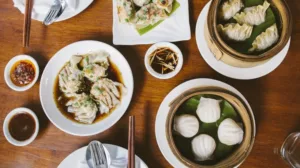
Table view of dim sum© E_rasmus/Getty Images
One of the best ways to experience Chinese food is the meal known as dim sum. Often eaten during mid-day, dim sum is comprised of many little dishes. Another example of communal eating popular in China, dim sum is a terrific way to try all kinds of tasty bits without having to order an entire plateful. If you’re an experienced eater, make sure you’re not missing the opportunity to try something new instead of ordering all the same dishes, no matter how delicious they might be.
If you’ve never been before, we have everything you need to know about ordering and what to expect. It can be overwhelming if you’ve never been; carts full of food pass by your table, people signaling the waitstaff, the sometimes confusing system of stamps, and all the food choices. As a cart goes by, patrons take a look at what’s on offer and pick dishes. The server stamps the bill and leaves the food. It’s really not much more involved than that. Typically, a dim sum meal can last for a while, so make sure to order as you’re ready to eat it rather than letting something get cold while you finish other plates. This will also help you to avoid becoming too full too fast.
Adding Extra Soy Sauce To Your Meal, Especially Rice
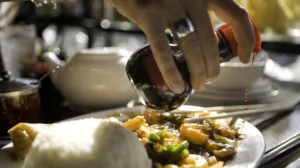
Pouring soy sauce on food© Webphotographeer/Getty Images
Much like adding salt to your meal, extra soy sauce isn’t always needed. In many restaurants, especially higher-end ones, you might even notice that neither salt nor soy sauce is even offered on the table, and this is because everything has been made with the best flavor in mind. While soy sauce is used a lot in Chinese cooking, it’s not used in excess, rather than having everything swimming in it. And that side dish of steamed rice is served plain for a purpose — it’s a carbohydrate-rich way to balance all the other bright and flavorful dishes on the table.
If you’ve ever tried making fried rice at home, you might think that adding more soy sauce is the best way to make it delicious. But take it from us, fried rice will always taste better at a restaurant unless you master the art of wok hei, the specific taste that comes from the high-heat cooking process used in Chinese homes and restaurants. The combination of a gas range and wok cooking is what gives the food its rich flavors, not the addition of more soy sauce.
Popping Soup Dumplings Before Eating
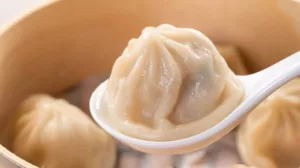
Soup dumpling in spoon© Romix Image/Shutterstock
If you’re a fan of Asian cuisines, and dumplings in particular, you’ve no doubt heard of (and hopefully tried) xiao long bao by now. Also called XLB, the soup dumplings originated in Jiangsu province and have recently seen a rapid rise in popularity worldwide. And for good reason — they’re absolutely delicious. There’s a specific way to eat these gorgeous little beauties, and it’s not by just jamming the whole thing in your mouth and letting the soup filling rush out in a burning hot river of flavor. The dumplings are best eaten while the filling is quite hot, so you don’t want to pop them either and risk losing the silky, rich broth.
Rather, there is a recommended four-step process to enjoy XLB with hot insides and the addition of dipping sauce. First, mix your vinegar and soy sauce in the provided bowl of ginger. Pick up a dumpling with your chopsticks and dip it into the sauce before placing it in your soup spoon. Finally, poke a tiny hole in the dumpling to release some of the broth and enjoy.
Cleaning Your Plate
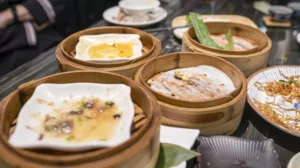
Empty dim sum table© Viviang/Getty Images
It can be tempting to order anything and everything, which you should (we believe in always trying something new), but what if you’re still hungry? Order another dish, we say. If that’s not feasible, think twice about cleaning your plate. Devouring absolutely everything, while tempting, can be insulting to the host. Licking your plate clean means that you didn’t get enough to eat (which you obviously didn’t if you’re thinking about ordering more), but it can make your host look cheap. And don’t even think about just leaving a heap of white rice, either, because it’s so accessible.
If you want to order more food but just can’t finish it all, feel free to pack some of it up to take home. Asking for a takeout container isn’t such a bad idea if you know how to reheat Chinese food properly.
Hot Pot
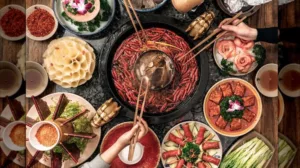
People eating hot pot© xiaoxiao9119/Shutterstock
If you’re new to the delicious experience known as hot pot, you’re in for an absolute treat. Here are some of the facts — a large bowl of broth is placed on a heating element in the middle of the table, surrounded by every type of meat and veggie imaginable. The broth can range from hot and spicy to milder ones. Often, the pot will be divided into two sections, allowing you to order a second broth. The heating element keeps the liquid hot so you can cook throughout the meal.
For the uninitiated, hot pot brings up some questions. First, you’ll be given two sets of chopsticks — one set for your personal use and the other for adding foods to broth. There may also be another set on the table that should be used strictly for raw meats and seafood. You’ll need to plan ahead when adding food to the broth. Some items will only take 30 seconds or so to cook, but frozen items like dumplings or large slices of harder veggies can take a few minutes. Timing is everything here. Just dumping a pile of food into the broth is very rude; not only does it look gluttonous, but it can also make the broth cool down very quickly.
Thinking That Fortune Cookies Are The Only Dessert
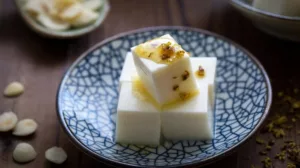
Almond jelly dessert© Innesslam/Shutterstock
If you’ve come to the end of your meal and think that the only sweet treat available is a pre-packaged fortune cookie, you’re missing out on some truly delightful ways to end your meal. Chinese desserts are usually quite light and not overly sweet, so you can indulge in one without feeling like you’ve gone overboard. There will be lots of things you recognize, but if you’re feeling a little adventurous, some restaurants will have a few options that might surprise you. Trust us; they’re all worth a try.
You should be able to find a few options that rely on fruit if that’s your thing. Sometimes combined with almond jelly or sweetened tofu, pears, lychees, or melon, all are common. Steamed buns will often make an appearance, filled with everything from red bean paste to peanut butter to salted duck egg custard. Fried milk might sound strange, but it’s actually just made from a mixture of coconut milk, cornstarch, and sugar, cut into squares, and deep fried. And it’s just as tasty as it sounds.
Ignoring The Traditions Of Tea
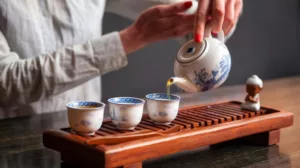
Woman pouring tea© Luckyraccoon/Getty Images
In many restaurants, the first thing you’ll be served is tea. Tea is an incredibly important part of Chinese culture and has important etiquette rules of its own. Tea will always be poured for you as a sign of respect. Accept graciously and say thank you. Like food, elders and special guests should be served their tea first before moving on to the rest of the party.
When the pot is empty, you can request a refill by tilting the lid or placing it upside down, signaling to your server that you would like more. Always accept a cup of tea with two hands; this indicates that you acknowledge the tea’s importance and show respect to your hosts. Sip slowly throughout the meal as this encourages digestion and, again, is a sign of respect. Depending on the restaurant, you may be served a number of different types of tea but jasmine or oolong are pretty typical. If you would like a particular type of tea, feel free to order it. Again, asking your server for recommendations depending on your plan to eat is also appreciated.


